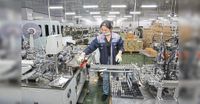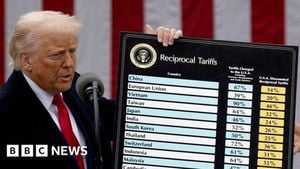As the global manufacturing sector navigates a patchwork of economic headwinds and policy shifts, the latest data from August and July 2025 paints a picture of uneven recovery and persistent uncertainty. From Asia’s export powerhouses to Europe’s industrial heartlands, the world’s factories are contending with tariffs, shifting demand, and political maneuvering that continue to shape their fortunes in unpredictable ways.
In Taiwan, the mood among manufacturers has turned decidedly somber. According to the Taiwan Institute of Economic Research (TIER), the island’s manufacturing sector contracted for the third consecutive month in July 2025. TIER’s composite index fell by 1.38 points from June, landing at 8.48—well below the 10.5-point threshold that signals contraction. This “blue light” warning, part of TIER’s five-color system, reflects the mounting pressures facing Taiwanese industry. Chief among these are new U.S. tariff policies, including a 20 percent levy on Taiwanese goods effective August 7, and a strengthening Taiwan dollar that’s squeezing exporter margins. The situation is further complicated by a Section 232 investigation launched by Washington in April, which could pave the way for tariffs on semiconductors—one of Taiwan’s most vital exports.
TIER’s July report found that 87.86 percent of respondents experienced contraction conditions, a significant jump from 66.76 percent in June. Only 4.48 percent reported stable growth. While high-tech sectors such as electronics components and information technology continued to benefit from robust demand for emerging technologies, traditional sectors like base metals and auto parts struggled. The base metal industry, for example, continued to contract amid sluggish demand from the U.S. and Europe, and the auto sector saw sales plunge 22.3 percent year-on-year in July as consumers hesitated amid tariff uncertainty.
Across the Taiwan Strait, however, China’s manufacturing sector offered a rare glimmer of optimism. The private RatingDog China General Manufacturing PMI, compiled by S&P Global, rose to 50.5 in August from 49.5 in July—its quickest pace of growth in five months and above the 50-mark that separates expansion from contraction. This result surpassed analysts’ expectations and contrasted with an official survey that showed factory activity continuing to shrink for a fifth straight month. According to Yao Yu, founder of RatingDog, “The manufacturing sector is helping the recovery, but this rebound is patchy. With weak domestic demand, potentially overstretched external orders, and slow profit recovery, the durability of the improvement depends on whether exports truly stabilise and whether domestic demand can pick up pace.”
The PMI’s new order growth accelerated to its fastest since March, resulting in the quickest accumulation of backlogged work in six months. Still, manufacturers remained cautious, shedding staff for a fifth consecutive month despite greater capacity pressures. Input costs rose at their steepest rate since November 2024, driven by higher raw material costs, while supplier lead times lengthened for the sixth month in a row due to shipping delays and logistics constraints. Despite these challenges, factory bosses remained optimistic about the one-year outlook for output, with confidence at its highest since March.
Indonesia, meanwhile, has emerged as a bright spot in the region. The country’s Manufacturing PMI surged to 51.5 in August from 49.2 in July, marking a return to expansion after four months of contraction. Coordinating Minister for Economic Affairs Airlangga Hartarto credited the rebound to rising domestic and export demand. “The return of the manufacturing PMI to the expansion zone shows the continued improvement in domestic economic conditions and the increasingly stronger optimism of business actors in line with improving people’s purchasing power conditions and supporting production growth in the coming period,” Airlangga stated. New outputs and orders grew for the first time in five months, and export orders reached their highest level since September 2023. Labor and purchasing activities also increased, signaling positive prospects for the sector.
Indonesia’s trade balance reported a surplus of $4.17 billion in July, up 1.71 percent from the previous month, with exports outpacing imports. The trade surplus with the U.S. alone reached $2.2 billion for non-oil and gas sectors in July, even as Indonesian goods faced a baseline tariff of 10 percent for exports to the U.S. Airlangga also highlighted that growing manufacturing activity among Indonesia’s key trading partners—including India, ASEAN, and the European Union—has bolstered demand for Indonesian products. China remains Indonesia’s top export destination, followed by the U.S. and India.
Europe’s manufacturing sector, long battered by sluggish exports and trade tensions, finally showed tentative signs of recovery. The HCOB Eurozone Manufacturing PMI rose to 50.7 in August from 49.8 in July, marking the bloc’s first expansion since mid-2022. Growth was driven largely by domestic demand, which helped offset the impact of U.S. tariffs. “The recovery is real but remains fragile. Inventory levels continue to decline, and the slightly accelerated drop in order backlogs shows that companies are still suffering from uncertainty,” noted Cyrus de la Rubia, chief economist at Hamburg Commercial Bank. Greece and Spain led the factory growth, while Germany’s manufacturing sector, the largest in the Eurozone, edged closer to expansion with a PMI of 49.8.
Elsewhere in Asia, the mood was less upbeat. Japan’s manufacturing PMI in August stood at 49.7, up from 48.9 in July but still below the 50 mark for a second month, signaling continued contraction. South Korea’s PMI was even lower at 48.3, marking a seventh consecutive month of decline. Both countries have struck trade deals with the U.S. that have eased, but not eliminated, the pressure of steep tariffs on their export-driven economies. As Toru Nishihama, chief emerging market economist at Dai-ichi Life Research Institute, put it, “It’s a double-whammy for Asian economies, as they face higher U.S. tariffs and competition from cheap Chinese exports. We’ll likely see the hit from U.S. tariffs intensify going forward, with countries reliant on U.S.-bound shipments like Thailand and South Korea particularly vulnerable.”
Russia’s manufacturing sector continued to struggle, contracting for the third straight month in August with an S&P Global PMI of 48.7. Output and new orders fell in both domestic and export markets, with weak demand and financial difficulties among clients cited as key factors. New export orders contracted for the fifth time in six months. Yet, in a twist, employment in the sector grew at its fastest pace since July 2024, as firms hired more full-time employees and extended shift patterns. Manufacturers expressed renewed optimism about future output, driven by planned investments in advertising and new product launches, though the sector’s momentum has clearly slowed.
Looking ahead, economists warn that the global manufacturing outlook remains clouded by persistent trade tensions—especially with the U.S. imposing or threatening new tariffs on multiple fronts—and by the risk that payback from frontloading shipments earlier in the year could sap momentum. The property sector’s stagnation in China and weak demand in Europe and the U.S. further complicate the picture. While some regions, like Indonesia and parts of the Eurozone, are finding ways to adapt through stronger domestic demand or targeted policy support, others remain at the mercy of shifting global currents and the unpredictable winds of international trade policy.
The coming months will test whether recent gains can be sustained or if the patchwork recovery will unravel under the weight of tariffs, currency fluctuations, and political uncertainty. For now, the world’s manufacturers are bracing for another season of change.





